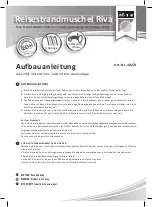
Setting up the product
13
NOTICE!
Risk of damage!
Strong wind or a storm may pull the product out of the anchors and
damage it.
− Preferably choose a wind-protected area for set-up.
− Set the product up so that the wind can blow over the product
from the back of the product.
− Use the guy ropes and pegs to secure the product and protect
it against the wind.
• Set up the product before a trip to familiarise with the product’s
construction.
• Choose an area that is large enough to accommodate not only the
tent, but also ensure there is enough space to each side surround-
ing the tent to tie down the guy ropes to the ground.
• The net insert in the tent permits adequate ventilation and, at the
same time, prevents insects from entering the product.
• The product consists of an outer
15
and an inner tent
16
, which
are separated by a door. The inner tent typically serves as a bed-
room, while the outer tent is used as a living room/lounge.
1. Select a suitable, level set-up location where you can properly secure the
product by attaching the guy ropes
2
to the ground using the pegs
7
.
Ensure the ground is free of stones and other sharp objects.
2. Take the tent
1
, the fibreglass pole
6
as well as the pegs out of the carry
bag
3
(see
Fig. A
).
3. Spread out the tent with the dark grey underside facing downwards at the set-
up location (see
Fig. B
).
4. Secure the tent on the ground by using the pegs
7
to secure the tent loops
8
in the ground (see
Fig. B
). Use a hammer
19
if necessary to drive the pegs into
the ground.
Make sure that the underside of the tent is tensioned and that the pegs do not
protrude from the ground.
5. Locate the air valves
9
on the tent (see
Fig. C
) and make sure the lower parts
of the valves are fully screwed onto the tent to prevent air from escaping while
inflating. Open the locking caps of the air valves.
6. Fit the correct valve adapter
5
to the air hose and insert it into the air valve on
the side of the inflatable pole (middle)
10
.
Summary of Contents for Adventuridge AD78
Page 3: ...3 Scope of delivery Dok Rev Nr 199001_20210205 A B 1 3 4 5 6 7 1 8 7 2 Scope of delivery ...
Page 4: ...4 Scope of delivery C D E 1 9 10 11 4 4 ...
Page 5: ...5 Scope of delivery F G H 4 13 6 14 Front Rear Type I Type II Type III 2 12 ...




































